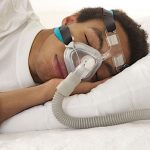 Temporary cessation in breathing (occurring during sleep).
Temporary cessation in breathing (occurring during sleep).
The cessation of breathing, especially without apparent cause.
Sleep apnea is a sleep disorder—specifically, hypersomnia that is associated with apnea, hypoventilation, or both. The disorder causes temporary cessation of breathing that occurs several times a night. Sleep apnea is typically classified as central or obstructive. In central apnea, blood oxygen levels decrease to the point breathing ceases and the sleeper awakens in order to start breathing normally. The individual typically recalls being awake in the night, therefore, more likely to report sleep as a problem. Individuals with obstructive sleep apnea (OSA), the most common type of apnea, often attribute their fatigue during daytime to depression or other medical problems. OSA involves either a partial or a complete blockage of the airway during sleep. Respiratory effort either is reduced significantly or ceases entirely during that period; this causes a desaturation of oxyhemoglobin and in some cases cardiovascular problems. Heavy snoring and lack of adequate airflow reduce the amount of deep (and satisfying) sleep an individual receives— hence the increased daytime sleepiness. Although periods of awakening occur, they are often so brief there is no memory of this. As a result, OSA is often difficult to diagnose and inadequately treated.
State of not breathing; arrest of respiration. Attacks of temporary apnea occur in some people during sleep (sleep apnea) and in some newborn babies.
A total cessation of breathing, either momentarily or for a prolonged period. Prolonged apnea, which can be life-threatening, may occur as a result of a stroke or transient ischemic attack (a brief interruption in blood supply to the brain, resulting in temporarily impaired sensation, movement, vision, or speech); as an effect of certain drugs; or as a result of airway obstruction. Loud snoring accompanied by pauses in breathing while sleeping is a symptom of potentially life-threatening sleep apnea syndrome. Other symptoms of sleep apnea include daytime sleepiness, fatigue, and headache. Sleep apnea is most common in overweight people, as excessive body fat puts pressure on breathing passages. In Cheyne-Stokes respiration, alternating periods of apnea and deep, rapid breathing occur.
Temporary cessation of breathing and, therefore, of the body’s intake of oxygen and release of carbon dioxide. It is a serious symptom, especially in patients with other potentially life-threatening conditions.
Intermittent moments of suspended respiration, alternating between abrupt occurrences and extended durations.
The lack or temporary cessation of breathing; it can also refer to asphyxia.
